Everyone knows about tuatara – right? Most New Zealanders know that our tuatara was around in dinosaur times and out-survived all the dinosaur ‘big names’ like Tyrannosaurus Rex. And we all know what a tuatara looks like. But how much do you actually know about them?
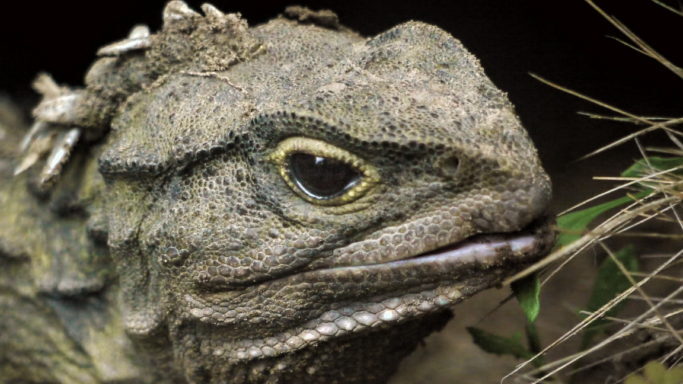
The tuatara is much more than just ‘world famous in New Zealand’. Scientists and the wider public have been fascinated by them since early days and hundreds of specimens were once shipped overseas for museums and private collections. That led to the tuatara becoming one of New Zealand’s first native species to be fully protected by law in 1895. Poaching is still a problem, but nowadays the tuatara’s legal protection and remote locations help to protect it.
Tuatara (Sphenodon punctatus) are the only surviving members of the order Sphenodontia. Spenodontia once consisted of many species back in the age of the dinosaurs, 200 million years ago, but all except the tuatara declined and eventually became extinct about 60 million years ago.
Tuatara aren’t lizards. But they are our largest reptile, with adult males measuring up to about a half metre in length and weighing up to 1.5 kg when fully grown. You can recognise a male by the distinctive crest of spines running along his neck and down his back – much more noticeable than the spines of females. They’re part of his macho sex appeal and he can fan them out to attract females or when fighting with other males.
These spiny plates on the back and tail of the tuatara resemble those of a crocodile more than a lizard, but the tuatara shares with lizards the ability to break off its tail when caught by a predator, and then regenerate it. The regrowth takes a long time, however, and differs from that of lizards.
Males become sexually mature when they reach a snout-vent length (SVL) of about 180 mm but size matters in the reptile world and a male may not get an opportunity to breed until he’s grown much larger than this. Mating occurs during January–March when the male holds a territory. Here he will display to ward off intruders and to court receptive females.
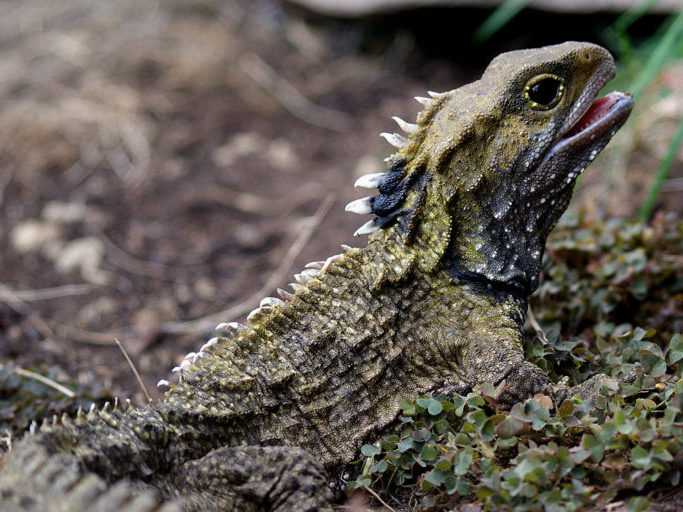
Male tuatara don’t have a penis. Along with birds, the tuatara is one of the only members of amniota (birds, reptiles, mammals and their ancestors) to have lost the ancestral penis. Instead they reproduce by the male lifting the tail of the female and placing his vent over hers in a process sometimes referred to as a “cloacal kiss”. The sperm is then transferred into the female, much like the mating process in birds.
Females will breed at 13 years old and a SVL of about 170 mm. But the slow rate of egg yolk production in tuataras means that wild females don’t breed every year. The average time between clutches is 4 years. So, like many of our unique wildlife, tuatara are long-lived, but slow breeders.
In the year that breeding does occur, the female will ovulate within 1–2 months of mating and carries the eggs in her oviduct, where they will slowly become shelled, until laying in October–December. She excavates a small burrow, usually choosing an open site, north-facing so its warmed by the sun.
Here she’ll lay 9–10 eggs on average, back-fill the nest and guard it for several days before abandoning the eggs to their long incubation period. Tuatara eggs have a soft, parchment-like 0.2 mm thick shell that consists of calcite crystals embedded in a matrix of fibrous layers. During the 11–16 month incubation many eggs are likely to be destroyed by other burrowing females or they will succumb to desiccation and insect predation.
It takes the females between one and three years to provide eggs with yolk, and up to seven months to form the shell. It then takes between 12 and 15 months from copulation to hatching. This means reproduction occurs at two- to five-year intervals, the slowest in any reptile.
Hatching success in the wild is about 42% – but the dangers are far from over yet. Adult tuatara can be cannibals. They’re also mostly nocturnal, so it makes sense that during their first 2 very vulnerable months the hatchlings are diurnal, hiding under logs and stones. It decreases the odds that they’ll encounter a hungry adult. Within a year they begin to burrow and become nocturnal.
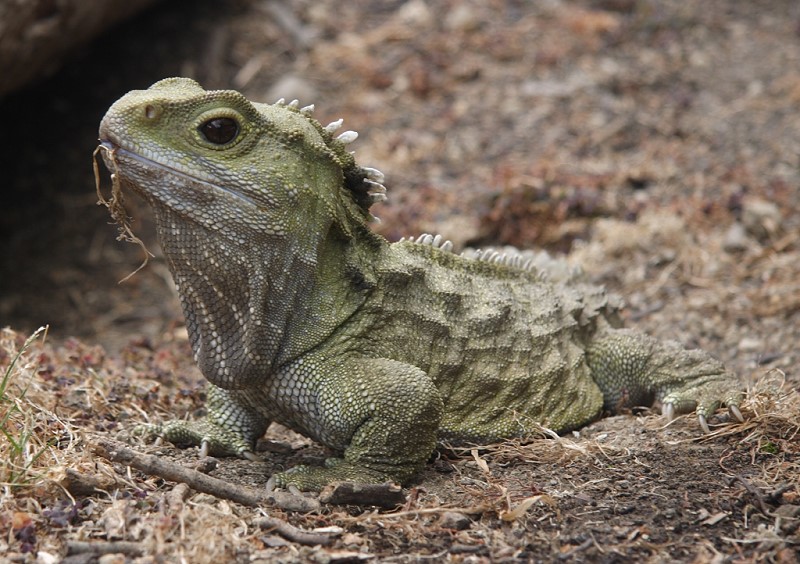
Incubation of tuatara eggs in a controlled environment has a greater hatching success rate and has also revealed that incubation temperature has an influence in determining the sex of the hatchlings. Warmer eggs tend to produce male tuatara, and cooler eggs produce more females. Eggs incubated at 21 °C have an equal chance of being male or female. However, at 22 °C, 80% are likely to be males, and at 20 °C , 80% are likely to be females; at 18 °C all hatchlings will be females.
Tuatara have one of the slowest growth rates of any reptile, and they keep growing until they are about 35 years old, shedding their skin several times a year as hatchlings then once per year as adults. A tuatara’s average life span is about 60 years but they probably live up to 100 years. In captivity they may live even longer – some scientists think they may live up to 200 years.
One well-known captive tuatara is Southland Museum’s ‘Henry’ who became a father (possibly for the first time), with an 80-year-old female, Mildred, on 23 January 2009, at the ripe old age of 111. Mildred laid 12 eggs and, after 223 days of incubation, 11 baby tuatara successfully hatched.
Henry was something of a slow starter, even for a tuatara. Previously he had always ignored females, or attacked them but all that changed once a long-time cancerous growth was removed.
Henry is thought to have been born around 1900 and joined Southland Museum in 1970. In 2020 he celebrated a 50-year relationship with his long-time curator.
So much about tuatara is unusual. Unlike most reptiles they actually like cool weather. They don’t survive well over 25°C, but can live below 5 degrees, by sheltering in burrows and hibernate during winter. Temperatures over 28 °C are generally fatal. Global warming is not good news.
The optimal body temperature for the tuatara is from 16 to 21 °C, the lowest of any reptile. The body temperature of tuatara is lower than that of other reptiles, ranging from 5.2–11.2 °C over a day, whereas most reptiles have body temperatures around 20 °C. This low body temperature results in a slower metabolism.
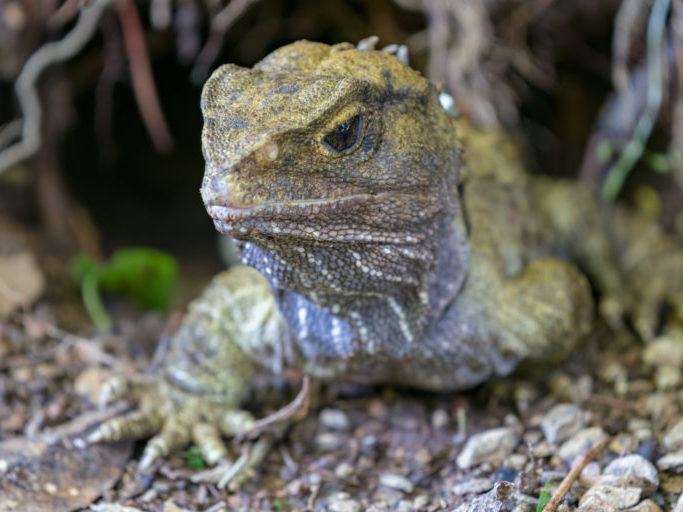
Tuatara teeth are weird too.
While they look similar some other modern reptiles, tuatara (and other sphenodontian relatives), are characterised by their unique dental arrangements. A single row of lower teeth fits into a groove between two rows of upper teeth – something not seen in any other living species. A specialised jaw movement allows the tuatara’s teeth to exert a shearing effect on its food, meaning they can cut through chitin and bone. Fossils indicate that the jaw mechanism began evolving at least 200 million years ago.
The teeth are not replaced. As their teeth wear down, older tuatara have to switch to softer prey such as earthworms, larvae, and slugs, and eventually have to chew their food between smooth jaw bones. This may have led to a common misconception that tuatara lack teeth and instead have sharp projections on the jawbone. In fact they do have enamel and dentine with pulp cavities.
In many ways, the tuatara is primitive – or at least very unspecialised. It’s brain and mode of locomotion resemble those of amphibians and the heart is more primitive than that of any other reptile. The lungs have a single chamber and lack bronchi. And yet, researchers mapping the tuatara’s genome have discovered that the species has between 5 and 6 billion base pairs of DNA sequence – that’s nearly twice the base pair number of humans. Simple but sophisticated, perhaps?
Tuatara also have three eyes – well sort of… They have a pronounced photoreceptive eye, the parietal eye, which is thought to be involved in setting circadian and seasonal cycles. It has its own lens, a parietal plug that resembles a cornea, retina with rod-like structures, and degenerated nerve connection to the brain.
The parietal eye is visible only in hatchlings, which have a translucent patch at the top centre of the skull. After four to six months, it becomes covered with opaque scales and pigment. It may be useful in absorbing ultraviolet rays to produce vitamin D, as well as to determine light/dark cycles, and help with thermoregulation.
The parietal eye is part of the pineal complex, another part of which is the pineal gland, which in tuatara secretes melatonin at night. Some salamanders have been shown to use their pineal bodies to perceive polarised light, and thus determine the position of the sun, even under cloud cover, aiding navigation. Might tuatara do something similar? We still have much to learn.
The tuatara’s ‘normal’ eyes can focus independently, and are specialised with three types of photoreceptive cells, all with fine structural characteristics of retinal cone cells used for both day and night vision, and something called a ‘tapetum lucidum’ which reflects onto the retina to enhance vision in the dark. Tuatara probably have good colour vision, possibly even at low light levels.
Tuatara are able to hear, although no external ear is present. Together with turtles, the tuatara has the most primitive hearing organs among the amniotes (birds, mammals, reptiles and their ancestors). There is no eardrum and no earhole, they lack a tympanum, and the middle ear cavity is filled with loose tissue, mostly fatty tissue. The hair cells are unspecialised and respond only to low frequencies.
Though their hearing organs are poorly developed and primitive with no visible external ears, tuatara can still show a frequency response from 100 to 800 Hz, with peak sensitivity of 40 dB at 200 Hz. Tuatara also have unique features in their skeleton, some of them apparently evolutionarily retained from fish.
As predators, tuatara also have some sense of smell through ‘odorant receptors’. Animals that depend on the sense of smell to capture prey or to escape from predators usually have many odorant receptors. The tuatara has several hundred receptors, somewhere around 472. That’s more similar to the number of receptors that birds have, rather than to the large number of receptors that turtles and crocodiles may have. Birds (other than our kiwi) aren’t famed for their great sense of smell.
Tuatara mainly eat invertebrates such as beetles, weta, worms, millipedes and spiders, but will also prey on lizards, seabird eggs and chicks and even, on occasion, their own young. Their colour ranges from olive green to brown to orange-red, and they can change colour over their lifetime.
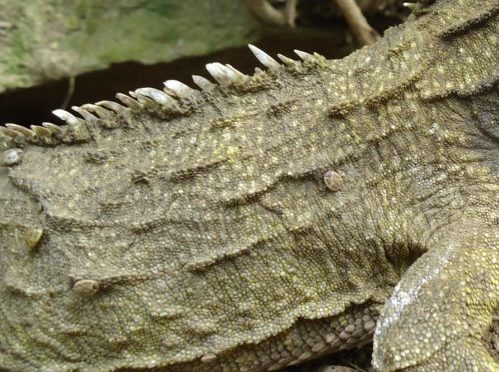
In prehistoric times, tuatara lived on mainland New Zealand, but they now survive in the wild only on rat-free offshore islands. Kiore are thought to have led to their mainland demise and there were probably few, if any, tuatara left on the North and South Islands by the time European settlers arrived.
Although adult tuatara can co-exist with kiore but it seems that tuatara eventually die out where kiore are present. Kiore are thought to have been tuatara nest robbers – taking eggs as well as small hatchlings. Because they are such very slow breeders, tuatara can’t make up for the losses of their young.
On their offshore island homes, tuatara live in burrows in coastal forest or scrub. Burrowing seabirds such as petrels, prions, and shearwaters share the tuatara’s island habitat during the birds’ nesting seasons. The tuatara use the birds’ burrows for shelter when available, or dig their own.
There’s another advantage to sharing your home with seabirds. The seabirds’ guano helps to maintain invertebrate populations on which tuatara predominantly prey; including beetles, crickets, and spiders. Then there’s the eggs and nestlings of the seabirds themselves…
Tuatara are most active at night but also bask in the sun during the day. Activity is greatest in warm wet weather. One other thing it might be wise to remember: tuatara of both sexes defend territories and will threaten and eventually bite intruders. The bite can cause serious injury. Tuatara will bite when approached and will not let go easily.

